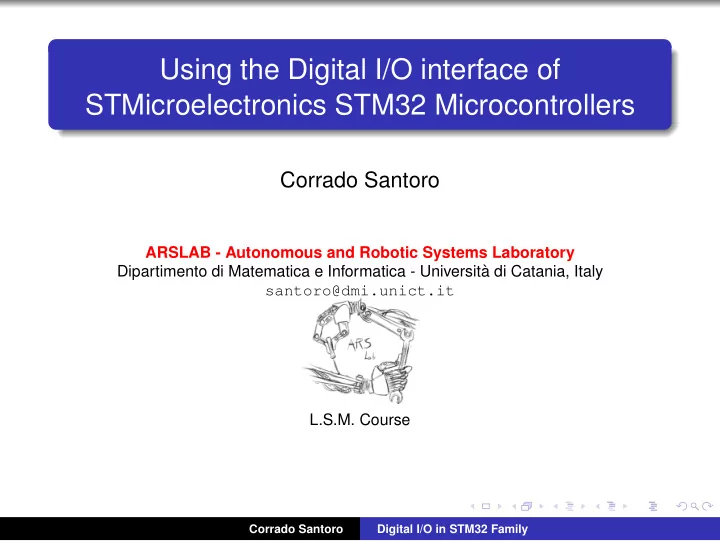

Using the Digital I/O interface of STMicroelectronics STM32 Microcontrollers Corrado Santoro ARSLAB - Autonomous and Robotic Systems Laboratory Dipartimento di Matematica e Informatica - Universit` a di Catania, Italy santoro@dmi.unict.it L.S.M. Course Corrado Santoro Digital I/O in STM32 Family
What is a “digital I/O interface”? It is an interface in which each electrical pin may have two states: Logical 0 (it means 0V); Logical 1 (it means 5V or 3.3V on the basis of the VDD); Each line can be programmer as: an output (it “generates” current and can be used, for example, to lit a LED) an input (it “receives” current and can be used, for example, to read a pushbutton) Corrado Santoro Digital I/O in STM32 Family
The General Purpose I/O (GPIO) Interface of STM32 MCUs of the STM32 family have several digital ports , called GPIOA , GPIOB , GPIOC , ... , Each port has 16 bits and thus 16 electrical pins Pins are referred as P xy , where x is the port name (A, B, ..., E) and y is the bit (0, 1, ..., 15). As an example, the pin PC3 is the bit 3 of the port C. Each PIN has also an alternate function , related to a peripheral e.g. Timer, UART, SPI, etc. According to the MCU package, not all bits are mapped to electrical pins. This is a choice “by-design”. Corrado Santoro Digital I/O in STM32 Family
The General Purpose I/O (GPIO) Interface of STM32 Corrado Santoro Digital I/O in STM32 Family
Using the GPIO Interface To use a specific GPIO line (pin), the following operations are needed: Set-up 1 Initialize the whole GPIO port (this operation basically enables the clock line to the GPIO port) Set the direction (input or output) of the pin you intend to use 2 Operate Read the GPIO pin, if it is programmed as “input”, or Write the GPIO pin, if it is programmed as “output” These operations are made really simple using the stm32 unict lib Corrado Santoro Digital I/O in STM32 Family
Using the GPIO Interface with stm32 unict lib Example: setting PA5 as output and using it Set-up 1 Initialize the whole GPIO port (this operation basically enables the clock line to the GPIO port) GPIO init(GPIOA); Set the direction of the pin you intend to use 2 GPIO config output(GPIOA, 5); Operate Write “0” to PA5: GPIO write(GPIOA, 5, 0); Write “1” to PA5: GPIO write(GPIOA, 5, 1); Corrado Santoro Digital I/O in STM32 Family
The Nucleo64 Addon Board Corrado Santoro Digital I/O in STM32 Family
First Example: Flashing a LED ✞ #include "stm32_unict_lib.h" int main() { // initialize port B GPIO_init(GPIOB); // configure pin PB0 as output GPIO_config_output(GPIOB, 0); // infinite loop for (;;) { GPIO_write(GPIOB, 0, 1); // set PB0 to 1 delay_ms(500); // wait 0.5 secs GPIO_write(GPIOB, 0, 0); // set PB0 to 0 delay_ms(500); // wait 0.5 secs } } ✝ ✆ ✡ Corrado Santoro Digital I/O in STM32 Family
Using the GPIO Interface with stm32 unict lib Example: setting PC3 as input and using it Set-up 1 Initialize the whole GPIO port (this operation basically enables the clock line to the GPIO port) GPIO init(GPIOC); Set the direction of the pin you intend to use 2 GPIO config input(GPIOC, 3); Operate Read PC3 pin: int pinval = GPIO read(GPIOC, 3); “pinval” can be “0” or “1” Corrado Santoro Digital I/O in STM32 Family
First Example: Read a Pushbutton and lit the LED ✞ #include "stm32_unict_lib.h" int main() { // pushbutton on PB10; LED on PC2 // initialize ports GPIO_init(GPIOB); GPIO_init(GPIOC); // configure pin PB10 as input GPIO_config_input(GPIOB, 10); // configure pin PC2 as output GPIO_config_output(GPIOC, 2); // infinite loop for (;;) { int pinval = GPIO_read(GPIOB, 10); GPIO_write(GPIOC, 2, !pinval); } } ✝ ✆ ✡ Corrado Santoro Digital I/O in STM32 Family
Inside the code.... What are the GPIOA, GPIOB, ... variables? What are the prototypes of the GPIO functions? GPIOA, GPIOB, ... are global variables defined in CMSIS libraries as: GPIO TypeDef * GPIOA; GPIO TypeDef * GPIOB; ...; GPIO TypeDef is a structure whose fields are the special-function-registers (SFRs) of a GPIO port Each GPIOA, GPIOB, ... variable is a pointer to a GPIO TypeDef and represents the address of the memory holding the SFRs of that port Corrado Santoro Digital I/O in STM32 Family
The GPIO function prototypes Initialize a GPIO port: void GPIO init(GPIO TypeDef * port); Configure a GPIO pin as input: void GPIO configure input(GPIO TypeDef * port, int pin num); Configure a GPIO pin as output: void GPIO configure output(GPIO TypeDef * port, int pin num); Write to an output pin: void GPIO write(GPIO TypeDef * port, int pin num, int pin val); Read from an input pin: int GPIO read(GPIO TypeDef * port, int pin num); Change the state of an output pin: void GPIO toggle(GPIO TypeDef * port, int pin num); Corrado Santoro Digital I/O in STM32 Family
Using the Digital I/O interface of STMicroelectronics STM32 Microcontrollers Corrado Santoro ARSLAB - Autonomous and Robotic Systems Laboratory Dipartimento di Matematica e Informatica - Universit` a di Catania, Italy santoro@dmi.unict.it L.S.M. Course Corrado Santoro Digital I/O in STM32 Family
Recommend
More recommend